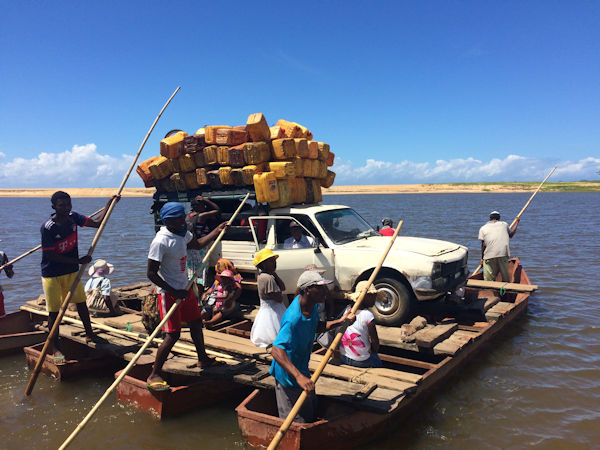SEJournal Online is the digital news magazine of the Society of Environmental Journalists. Learn more about SEJournal Online, including submission, subscription and advertising information.
 |
| For two young journalists tracking the path of illegal rosewood trade, travel in northeastern Madagascar required crossing rivers in rafts like this one. Photo: Edward Carver. Click to enlarge. |
FEJ StoryLog: Grant Helps Chart Illegal Rosewood’s 10,000-Mile Journey
By Sandy Ong and Edward Carver
Edward Carver and Sandy Ong met as graduate journalism students at New York University, where their shared interests led them both to take classes on environmental reporting and international reporting. Afterwards, as they kept in touch while trying to navigate their way as freelance reporters far away from New York City, they stumbled across an idea that would win them a grant from the Society of Environmental Journalists’ Fund for Environmental Journalism. Here’s their StoryLog.
In 2017, Edward was based in Madagascar, a large island off the southeast coast of Africa, where a large-scale illegal wildlife trade had taken root, partly because of demand from China. An idea sparked: Sandy was now living in Asia and could speak Mandarin — perhaps we could jointly explore the impact that China has on the environment in Madagascar and Africa?
 |
| Sandra Ong. Click to enlarge. |
After bouncing around a couple of ideas on what species to focus on, from sapphires to sea cucumbers, we eventually settled on rosewood, largely because of the astounding volume of the trade.
The tropical timber, with its beautiful dark red interior used in traditional Chinese furniture, is (and this was a fact we were surprised to learn) the most widely traded form of illegal wild product in the world.
Rosewood doesn’t quite have the notoriety of pangolin scales, elephant ivory or rhino horns, but we thought that readers might be similarly intrigued.
Work on our story began the way nearly all journalism does — with a deep dive into the literature and reaching out to sources. We spoke to academics in the field, trawled through reports written by non-governmental organizations (most notably the Environmental Investigation Agency) and read work by fellow journalists who had previously reported on the topic to try to find fresh angles.
Bit by bit, we began to piece together the “soup to nuts” journey that rosewood takes as it makes its way some 10,000-plus miles from Africa to China, transforming from massive tree to intricately carved table or bed.
Field reporting, fixers were crucial
Along the way, we realized that to really do justice to the story and to be able to immerse readers in the way we hoped, it was imperative to report from the field. We decided to apply for the Fund for Environmental Journalism.
In applying, we found two things especially helpful: recommendation letters written by editors who were interested in our story, and leveraging the locations we were in and the languages we could speak. Much to our delight, we were awarded a grant at the beginning of 2018.
The grant made the field reporting possible. Edward traveled to very remote villages in northeast Madagascar, far from his home base in the capital of Antananarivo, traveling by plane, moto-taxi, traditional ferry and foot. Sandy visited six Chinese cities, hiring a fixer who guided her to the people and places involved in nearly all aspects of the trade.
The high of winning the grant, however,
was accompanied by a sort of reality check.
Trafficking networks were, by design, incredibly
opaque: How do we actually pull this off?
The high of winning the grant, however, was accompanied by a sort of reality check. Trafficking networks were, by design, incredibly opaque: How do we actually pull this off? There was no roadmap for tracking the rosewood trade within China, and it was difficult to figure out where in the vast country to go.
We wanted to see the ports where the logs enter the country, the wholesale warehouses where they are stored and the factories where they are sawed, shaped and polished into beautiful furniture. Finally, we wanted to see the sleek showrooms where they are sold. Fortunately, the fixer we hired and the sources we spoke to helped us narrow down the list and map out a route.
Madagascar presented its own challenges. As in other “source” countries, few people would speak on the record given the sensitivity of the topic: There were huge amounts of money at stake, and many government officials were rumored to be involved in the trade. In China, by contrast, people were happy to speak openly about rosewood — since once the logs enter the country, there’s no further effort to verify their legality.
Fortunately, Edward found a group of Malagasy activists willing to speak frankly about the illegal trade that enriches only a select few; the general population sees little benefit from the harvest of the rosewood trees, despite their immense value.
Two of his activist sources had recently spent long stints in jail for their criticism of the timber barons and the government, but they remained outspoken. They directed Edward to remote villages where he could find rosewood hidden underwater and buried underground beneath the sand. He traveled alone so as not to put them or any fixer at risk.
Among lessons learned, the value of diligence
Our on-the-ground reporting provided rich material for our stories. So like any writers, we had to figure out how to organize it. We decided to keep it simple and intuitive: soup to nuts, beginning to end. That is, we took the reader from the wood’s source in Madagascar to its destination in China.
 |
| Edward Carver. Click to enlarge. |
Eventually, the grant led us to publish two stories, one in YaleE360, “The Rosewood Trade: An Illicit Trail from Forest to Furniture,” which garnered hundreds of shares, Facebook reactions and tweets, with Yale E360 tweets specifically generating nearly 100,000 impressions, and the other in Science News (“Can Forensics Help Keep Endangered Rosewood Off the Endangered Black Market?”). The former was republished by the German magazine Welt-Sichten, which focuses on issues in the Global South.
We have also been contacted by Cites, Interpol, Amnesty International, and a number of conservation and civil society groups in Madagascar. And we were interviewed by a journalist making a podcast about plant crimes and a filmmaker producing a forthcoming documentary on the rosewood trade.
There were many lessons along the way as well. Our advice to future grantees reporting in the field would be to plan interviews carefully, anticipate the kinds of details you’d like to capture, take plenty of photographs as aides-memoires and be fastidious about doing up your notes and backing up your recordings every night.
Mainly, we found that extended field investigations were not as intimidating as they first seemed. Not surprisingly, the key, both in the planning and reporting phases, was diligence.
Sandy Ong is an independent science journalist based in Singapore. She covers stories on health, tech and the environment in the region and beyond. Her writing has appeared in the Atlantic, BBC, Undark, Wired, IEEE Spectrum and other publications. Edward Carver writes about politics, economics and the environment. He worked in Madagascar for many years and is now based in London. His work has appeared in the Guardian and Le Monde.
* From the weekly news magazine SEJournal Online, Vol. 6, No. 7. Content from each new issue of SEJournal Online is available to the public via the SEJournal Online main page. Subscribe to the e-newsletter here. And see past issues of the SEJournal archived here.













 Advertisement
Advertisement 




